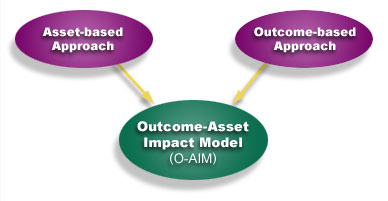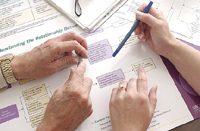Our Outcome-Asset Impact Model (O-AIM)
The previous section provides an introduction to outcome and asset approaches in human services. This section describes in detail how our model, the Outcome-Asset Impact Model (O-AIM), (Brown & Reed, 1998, 1999; Reed & Brown, 2001) merges the two approaches and combines them with other concepts and theories.
The O-AIM provides people and organizations with a framework for understanding social issues. It also provides them with the foundation for establishing a detailed strategic plan to guide them at every stage of the change process, including an evaluation framework to assess their progress.
NOTE— |
Although both outcome and asset approaches are useful and necessary, they are not sufficient alone to create healthy and capable communities. Outcome approaches guide us through the change process by helping us define the practical, incremental steps necessary for achieving the desired change; while asset approaches help us define the quality of the change, which is essential for achieving a capable community.

The framework of the O-AIM consists of three core concepts:
- Outcomes occur within an asset context.
- Outcomes occur on five interrelated levels.
- Outcomes at multiple levels must be considered.
A further description of these core concepts follows.
Outcomes occur within an asset context.
O-AIM focuses on asset-based outcomes. The implementation of the O-AIM begins with a discussion between MSU Outreach Partnerships and interested community members regarding the desired impact. This discussion includes the identification of existing community assets that are necessary to achieve the desired impact.
Impact statements are then developed to describe the desired future state or context, such as, “Youth have positive social skills, self-esteem, leadership skills, and good health,” or “People live in a healthy community.” Assets are the building blocks or characteristics of that desired impact. Together, the desired impact and its associated assets create the asset context.
Example—
Youth who have positive social skills, self-esteem, leadership skills, and good health have most of the Search Institute’s 40 Developmental Assets (Benson, 1997). Based on Search Institute research, the more assets available to youth the less likely they are to engage in risk-taking behavior.
The O-AIM also defines outcomes in people-centered terms, where the emphasis is not on types of activities that need to be implemented, but rather on how people can benefit, and how their conditions can change based on these activities and interventions. Working with local partners, and keeping in mind the overall impact (vision) that has been defined, we develop people-centered, asset-based outcome statements. These asset-based outcomes are expressed in three ways:
A more detailed description and examples of outcomes can be found in The Spectrum of Outcomes. |
- Long-term Outcomes that describe changes in the condition
or status of people.
Example—
“Youth resolve conflict nonviolently.”
- Intermediate Outcomes that describe changes in people’s
behavior.
Example—
“Youth begin to use nonviolent resolution strategies when confronted with conflict.”
- Initial Outcomes that describe the knowledge, beliefs, and skills
necessary for the change to take place.
Example—
“Youth learn and understand nonviolent conflict resolution techniques and strategies.”
Note: Notice that long-term outcomes are listed first, then intermediate, and initial. The reason for this is that a key aspect of the O-AIM is to start the process by defining your vision of a capable community first, then “working backwards” to find ways to achieve that vision.
Outcomes occur on five interrelated levels

The second key feature of the O-AIM is that it focuses on outcomes at multiple levels. The O-AIM helps communities concentrate their activities and interventions on the following five levels of interaction. Each level contains an example related to the development of safe and affordable housing within a community.
- Individual: one person at a time
Example: Children and adults need to live in safe and affordable housing.
- Family or Group: family members or within a small group
Example: Families must have the necessary resources to afford and maintain safe and affordable housing.
- Block, Organization, or Agency: among neighbors on a block, or within an organization of which one
is a member, or within an agency where one does business
Example: The housing authority has a program for making available safe and affordable housing to low income families.
- Neighborhood or Service Delivery System: relationships among people who live in a neighborhood or between
and/or among agencies that provide interconnected services
Example: Developing safe and affordable housing requires the contributions of contractors, the housing authorities, funding agencies, banks, and the city zoning and building offices.
- Community: the larger community where one lives
Example: The community has a commitment to the provision of safe and affordable housing for all income levels.
A further example of these levels and who they apply to can be found in Levels for Consumers and Agencies |
Once the long-term, intermediate, and initial asset-based outcome statements are generated for each level that is involved, activities and interventions are then identified that correspond to each statement. A logic model, or visual map, can be created that links outcome statements to activities at the various levels.
Outcomes at multiple levels must be considered
The final core concept of the O-AIM maintains that most situations are so complex that in order to achieve the desired impact, outcomes at multiple levels must be realized. Experience has shown that focusing on only one level will not likely result in the desired impact. This means that there must be an intentional development of activities at multiple levels. In the previous example, simply making affordable housing available to individuals does not necessarily mean successful home ownership.
For Further Reading: Research Base and Key Understandings
We believe that people who want to develop capable communities and create positive change must take into consideration some basic principles regarding human behavior and the nature of change. Concepts developed by various authors and researchers, in addition to asset and outcome approaches, have grounded O-AIM in theory and application and have established the principles upon which it is based. These theories and concepts are presented in detail in the Research Base section of the website.
Certain key understandings also have emerged from our synthesis of these sources that are the basis for the model and its facilitation. The following is a link to the Key Understandings
NEXT PAGE> Go to the next section to see how O-AIM is applied


